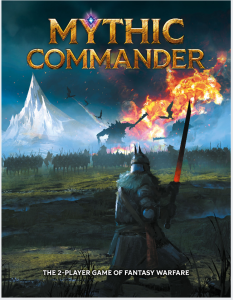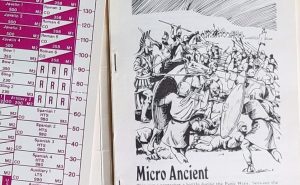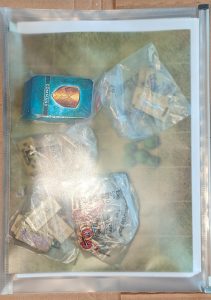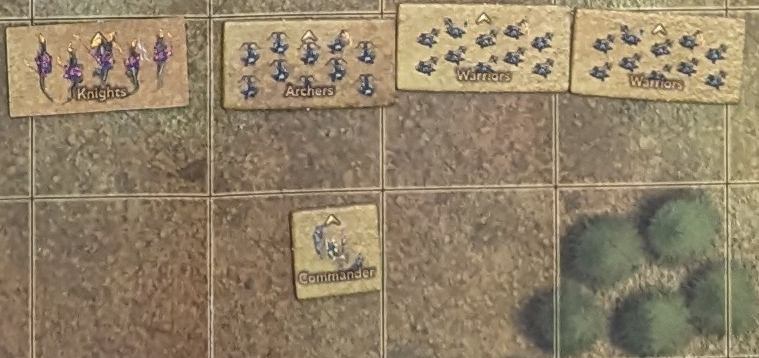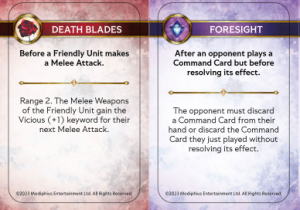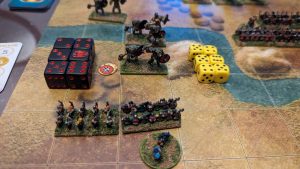Modiphius Publishing £16 + P&P
review by Colin D. Speirs
One of the first set of rules I ever owned was from Micro Ancients, from Tabletop Games. This wargame as a cardboard folder bound book of 1976’s state of the art wargames rules, army sheet and rules a cardboard sheet of unit counters to cut out and, with top-down terrain cut from cereal boxes, fight out a battle of Romans vs Carthaginians on the kitchen table. You can get a re-release in PDF if you want to revisit the distant past.
Mythic Commander , as you might expect almost 50 years later, is lightyears ahead, presentationally of those earlier rules. In a thin, shrinkwrapped packet, you get the 44 page rulebook, a double sided paper playing mat with terrain features and a 40mm square grid printed on it, sheets of carboard unit counters and other, thinner sheets with command and spell cards and tokens. The rear sheet for the product packaging has an army listing sheet to photocopy.
What this gives you is a set of grid based tabletop wargame rules using units representing troops and creatures from a top-down view. These counters are 40mm by 20mm, How coincidental or not that that is the size of bases in the old Warmaster system I do not know.
Buying this direct from Modiphius, the postage stung a bit because the price was over half that of the product but, on the other hand, I also got a link to download PDFs of all the above. I do not know if you get a “clicks and mortar” style deall to get those PDFs if you buy ir from someone else.
To actually use the ruleset you will need to add some d6s, pencil and paper will help.
Neat as the product is when you first get it, once you hace punched all the counters and cards, you are going to need some kind of box or a file wallet and ziploc or coin bags to put in the cards and counters into.
However, once that is done, you do not need to buy and paint figures, buy token sets or codices, everything you need to play some battles is right there, on the table
How does it work?
The game runs on an evolution of the system used in the “Airfix Battles” wargame. Each of the 40mm x 40mm squares can contain just one unit, plus attached leader and wound counters. Units are issued orders in alternate activation, so no waiting for your opponents to do all the things then you do all your things.
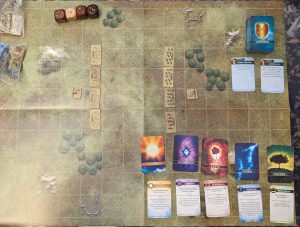 Players have a hand of command cards based on the leadership abilities of the characters in their army. Unlike Airfix Battles, you do not need to use a cards in activating it, you always have the basic choices for moving. attacking and rallying, you only use the Command Cards, to get special effects in activations, in response to the enemy or to discard for a bonus to gain iniitiative.
Players have a hand of command cards based on the leadership abilities of the characters in their army. Unlike Airfix Battles, you do not need to use a cards in activating it, you always have the basic choices for moving. attacking and rallying, you only use the Command Cards, to get special effects in activations, in response to the enemy or to discard for a bonus to gain iniitiative.
In each game turn, players
– refresh their command hand, based on the leaders they currently have (leaderless armies still get a random small amount of cards)
– dice for initiative, burning cards for bonuses
– take their alternating turns of maneuvering units and conducting fights
– deal with the effects of combat, notably morale and retreats
Units have a fairly familiar set of stats for movement, fighting ability, survivability and how long they hang around for. All are tested using d6s, sometimes it is roll under (attack and morale), sometimes roll over (armour save).
The ability of units to always maneuver and attack means that, unlike some command card based systems, you are not stuck with an inability to do things because you do not have units that match anything on the cards.
Unlike some rules, moving into the atack is not restricted to a charge. A charge is a special move where you damage the target before they get to fight back, but you can just stroll up and thump someone, though they fight back simultaneously.
In the clean up phase, units that took a lot of hits, will need to check for morale, and may end up retreating. If they fail to rally, they will eventually retreat off the map.
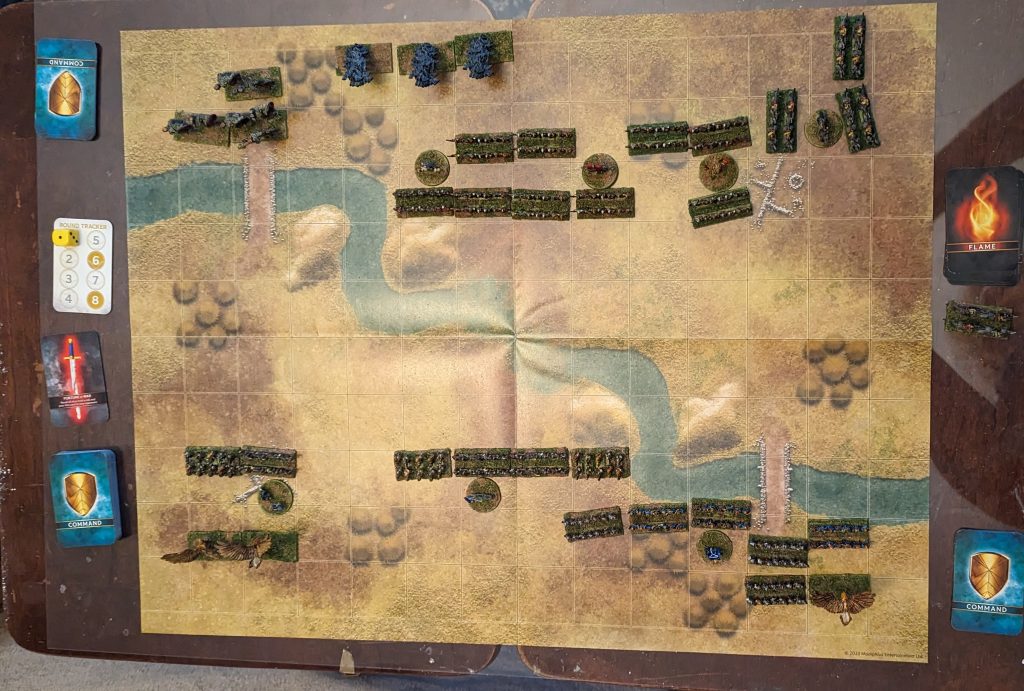
The squares include terrain features. Like a lot of the game, these have keywords, like “Vulnerable” for bridges, and the keyword explains the effect. In the case of “Vulnerable”, you discard one successful armour save when on the bridge.
Does it work well?
Although confined to a fairly small “low resolution” map, the TLDR version is yes. I have played a few times, both with counters and 10mm figures, and it comes up with a fun. quick game with tactical choices to make.
A hasty activation can come back to bite you e.g in one case, I hit enemy warg riders with , they started to retreat but could not because Eagles were in the square behind them, attacking someone else. Next turn they rallied and now threatened the rear of the Great Eagles!
Having it as alternate activation stops the “first to hit advantage” that IGOUGO wargames can be prone to, and the relative slowness for many units of moving and turning makes you consider your moves as you might find your opponent has now occupied the position you want.
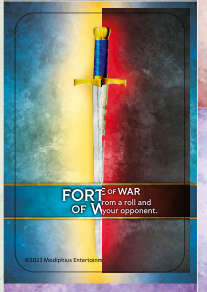
The double sided “Fortune of War” card, here shown spliced together. They are not the same on both sides, obviously.
Combat is swift and simple. In most cases the Unit rolls a d6 for each of its remaining Strength, that also being its hit-points. Each roll equal or over the relevant fighting skill is a Hit, and roll armour saves for each hit. Get too many hits, receive a Morale marker. Get way too many hits, you are destroyed.
The Command cards, allow units to interrupt attacks, to move and support units in unexpected ways, to strengthen defences, even to counter-act other cards and, of course, to declare charges.
Another nice mechanic is the “Fortune of War” card, allowing a re-roll of all dice for one roll, passing from player to player as it is used.
Command and the ability to have a re-roll all add a useful level of “Fog of War” to the players’ view of the battle.
It is a fast game, aside from the usual rules flipping as you learn the rules, but the basics are simple. There are special rules, because of unit type (light units maneuver differently, for example, than heavier ones), the faction and any special upgrades you buy.
It’s a Kind of Magic
It’s a long time since I have seen a fantasy wargame of invoking direct Divine or Infernal spirits to play a part on the field. Mostly the magical powers in fantasy wargames are
- to buff a unit
- to heal
- to act as heavy arillery
- to impede an enemy
Mages choose a type of Magic from one of the six types, and get the deck of Spells. They can cast one spell per round and then the spell is discarded.
Multiple mages can use the samre deck of spells. I *think* each mage gets their own deck, but the rules might be interpreted as them sharing it.
The rules for each spell is on the card, they are not repeated in the rules, and they are themed for the type.
- Death is about raising the dead, sucking the life from others, causing fear and revenge.
- Nature focuses on beasts and terrain.
- Flame mages cause a lot of damage, often to themselves.
- Storm can use the wind for movement, attack and defend
- Life is Healing and improving morale
- Divination gives you some advantages with Initiative, Command Cards and buffing attacks
I have not had a chance to use much magic in game, but when I did it seemed helpful, but not overwhelming or unbalancing. Flame mages are just chaotic, in a fun way, in retrospect.
Build-an-Army Workshop
There is no set world or set of racially based factions for the game, instead you get seven culture templates to choose from, those can be amended with a customisation, that provide a list of upgrades, for a price. If you know the game SmallWorld, the keyword system looks a bit like that, do you field the Barbaric Skillful Army or the Martial Stalwart Army?
Each culture has the exactly same mix of light and heavier infantry and cavalry, heroes and Siege Engines, with mostly, but not always, the same point cost for each type across the factions, but the light infantry of one faction might not be the same as the light infantry of another. E.g. Skilful Archers move more slowly than Fierce Archers, but the Skilful Archers are better with the bow and have better defence.
It is up to players to associate the culture and customisations with the fantasy Army they want to field. The “Undying” faction has a certain expectation around it, but Skillful might be Elves, or they might be the Horseblooded from the Coramonde books, or an army of assassins sent by the Old Man of the Mountain. With customisation the Elves become Skilful Ancients, the Horseblooded become Skilful Attuned and the Assassins stay as they are.
There are individual upgrades available for heroes and units, this is where the Commander of the Assassins might get a bonus for Strategy and his Champions Heroes get envenomed weapons. Finally there are Monsters and Special Units that armies can field, like the Great Eagles
From my battles so far, I think this simple system is effective at providing theme and customisation. The only kinds of armies that I don’t think I could make with this (someone will no doubt prove me wrong) are huge horde armies of utter trash or small armies of super-powerful individual units, but generally it fit most of the armies I thought of, despite me attempting to break it.
The counters
The counters are sturdy, and have enough different colours and illustrations to give variety to the units, but, and this is just personal, I did find distinguishing between them hard, but that is me and my terrible eyesight. Most are oriented across the long edge, with a few facing on the short edge, but, unlike, say, Warmaster, that has no game effect, because of the one unit per square rule.
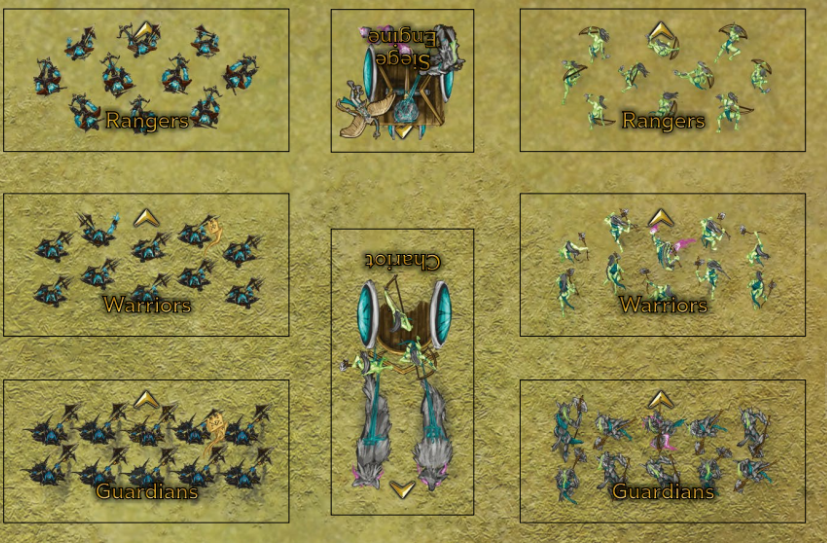 The counters are double sided, with a different unit type on the reverse to give you more choices, e.g Knights have Warriors on the other side, the other side of that short edge facing chariot is a long edge facing unit of archers.
The counters are double sided, with a different unit type on the reverse to give you more choices, e.g Knights have Warriors on the other side, the other side of that short edge facing chariot is a long edge facing unit of archers.
Scaling up
Moving up to figures on a wargames table should be simple for these rules.
Solutions I have seen for similar games moved to tables have included corner markers for the grid marked with tile spacers, or rocky outcrops on bases, or even tightly strung line denoting the space.
All you need to do is figure out the right size of grid, for a 6 foot by 4 foot table, 120mm would give a similar grid number to the included mat.
Is anything not so good?
- The game isn’t perfect. There are some unclear rules. E.g. Unit A attacks Unit B, melee ensues, both sides fighting. Is that the activation for Unit B, or do they get to activate in their own right. I have checked, they both get to activate, the game is intentionally deadly, but it should be explicitly stated.
- The tokens are flimsy and could easily get crushed and lost, They are certainly a bit difficult to pick up off the terrain mat. I think I will be using micro-dice for recording current hits where possible.
- The PDF sheets for cards and tokens have the Morale/Retreat tokens without the actual words on them
- There is a player’s aid on the inside back cover, but a double sided one with other information like the more common keywords, for terrain, faction and upgrade would be nice.
Conclusion
For the money, even with postage, this is a good value, solid transportable game. I found it very tactical in play, and flexible in the sort of armies you can field. There are very minor issues, but nothing I cannot deal with. I do hope that someone (not me at the moment, too much going on) produces a fuller play sheet, and I can see talented fans producing new counter tokens that are easier to read, or which suit the look of particular armies.
However, the minor caveats are more than overwhelmed by the fun and carnage of battle, and the joy of being able to produce an entirely new army simply by changing some stats on a sheet, rather than buying and painting tons of figures.
FWIW, I heartily recommend this.

